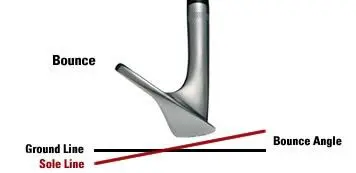Physical Address
304 North Cardinal St.
Dorchester Center, MA 02124
Physical Address
304 North Cardinal St.
Dorchester Center, MA 02124
What does Bounce do on a golf club? This is a question that many golfers have asked themselves. Many people think that bounce is simply there to make the club more difficult to hit, but this isn’t actually the case. Bounce plays an important role in how well you can play your shots.
So, what does bounce do on a golf club? Bounce is the angle between the club’s leading edge and the lowest point on the clubface. The bounce angle helps determine how much the ball will “lift” off the ground upon impact, and thus affects both distance and trajectory.
A high-bounce angle will result in a more penetrating flight, while a lower angle will create a “skidding” effect that can add distance but may be less forgiving on off-center hits.

In this blog post, we’ll break down what bounce is and how it affects your golf game.
“Bounce is forgiveness in a wedge. The better the bounce matches your swing type the better your wedge game will be.”
Bob Vokey
Have you ever looked closely at the sole of your golf wedge? Did you notice that right below the degree of loft number, there was a second number?
This second number is the degree of bounce that your wedge has. Each golf club has a certain degree of bounce. The bounce is angle between the ground and the sole of the golf club.

The bounce angle on a golf club affects how the club interacts with the ground. Wedges that have low bounce (4 – 6 degrees) will dig into the ground more than wedges with high bounce (10 – 14 degrees).
Low bounce wedges – As mentioned above, these wedges are between 4 and 6 degrees of bounce. These types of wedges are great in faster/firmer conditions and bunkers that are wet and have compacted sand.
Wedges with low bounce are engineered to give clean contact with the ball on each shot allowing more precision at the sacrifice of forgiveness. Log wedges with low bounce angles can produce high flop shots on very tight lines near the green.
Players with a shallower attack angle or a more “sweeping” motion tend to like these wedges more.
Medium bounce wedges – Wedges with medium bounce usually have between 7 and 10 degrees of bounce. These wedges are good in all conditions, firm and soft. Wedges with medium bounce are extremely versatile.
Players can use these wedges around the greens to create a number of shots. Players with a more natural swing like these type of wedges.
Typically, players with a very steep or very shallow swing struggle to use wedges with medium bounce.
High bounce wedges – High bounce wedges typically have bounce angles between 10 – 14 degrees. These types of wedges are suited for players with a steeper swing.
Because of how much bounce is on the club doesn’t dig into the turf as much and can help counter a steep swing. High bounce wedges help produce a lot of spin and can give players more control around the greens.
Some beginners that have a shallow swing struggle to hit these wedges as they are typically not getting under the ball as often. High bounce wedges cause them to hit more ‘thin’ shots.
The bounce of a golf club is the angle between the leading edge of the sole of the club and the ground. The sole is the part of the club that really interacts with the turf. The bounce angle prevents or helps the sole of the club dig into the ground, sand or turf.
There are benefits and drawbacks to each type of wedge bounce. Wedges with high bounce tend to not dig down into the turf as much and sort of ‘pop’ the wedge away from the ground. In contrast, wedges with low bounce tend to dig further into the ground, giving you a more precise hit.
The bounce of a golf club is a tool. Just as much as a rangefinder or any golf training aid. Using the bounce of a wedge is easier than you may think.
Using the bounce correctly starts with the knowledge about bounce and how that angle affects the club when it hits the ground. You need to take this information to the course and start applying it to situations.
Imagine you are on a par 3 with an elevated green and you are on the short grass, but you need to get the ball high in the air quickly. A wedge with high bounce may not be the club to hit at that moment, if you know that you have a problem getting under the ball, because of a shallow swing.
A club with low bounce will help you clip the ball quickly and can help you pop the ball up quicker.
One place bounce is extremely helpful is the sand. Imagine you are in a sand trap trying to pitch up onto the green. A wedge with low bounce can cause you to dig into the sand more and can cause you to hit under the ball easier.
However, a wedge with high bounce can stop you from digging as much an can help hit the ball a little more clean. A lot of players prefer higher bounce wedges out of the sand to avoid over digging.
There is no standard answer for what bounces you should get on your wedges. Bounce angles vary per wedge, grind, and brand.
The best answer to the question ‘what bounce(s) should I get on my wedges?’, is a variety.
At Bestgolfaccessories.net, we recommend that you get with a coach and professional fitter to properly get fit for a wedge set and to discover what type of swing you have.
The professional club fitter will help you get fit for your wedge set and a coach will help you figure out your swing and make recommendations on what type of wedges you need, how many wedges you need and more information that is vital in the bag making decision making.
Your coach can help you hone in your steep swing and a professional fitter can help get you set up with a wedge set of high to mid bounce wedges that will help you not dig too much into the ground.
If you decide to not use any coaches or fitters, we recording your swing and examining your divots to figure out what type of swing you have.
Then consider the types of wedges you are going to need – gap, sand, lob – and think about the types of situations you are going to use those wedges in.
Personally I play a 60 degree wedge with 4 degrees of bounce because, my swing is a drop steep and my local courses sand is commonly coarse.
Read more golf blogs such as, how to make a golf yardage book.